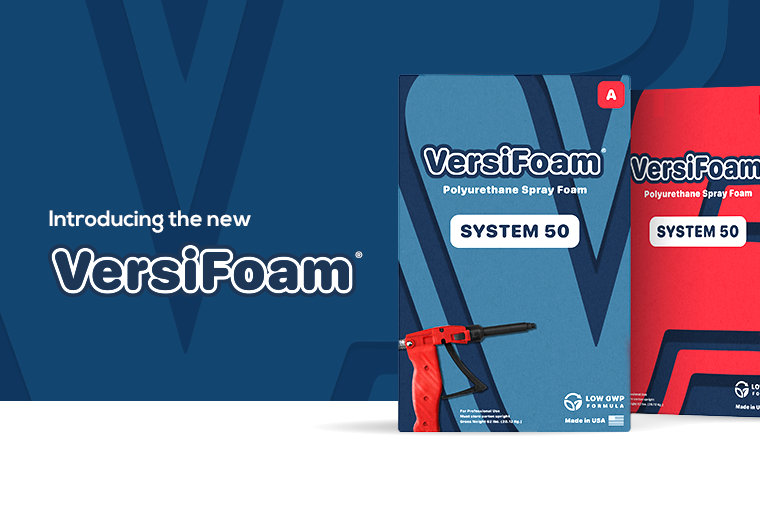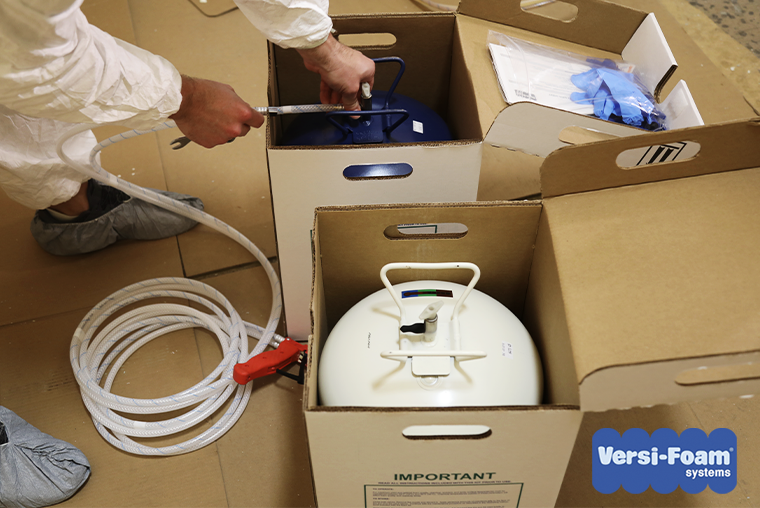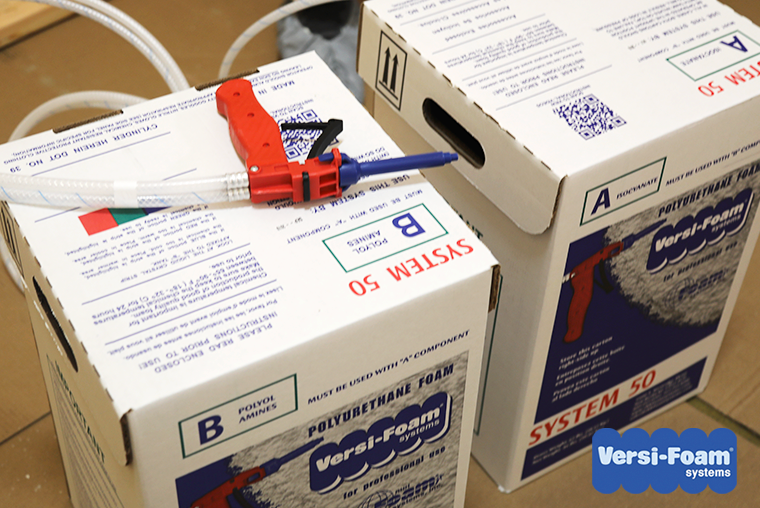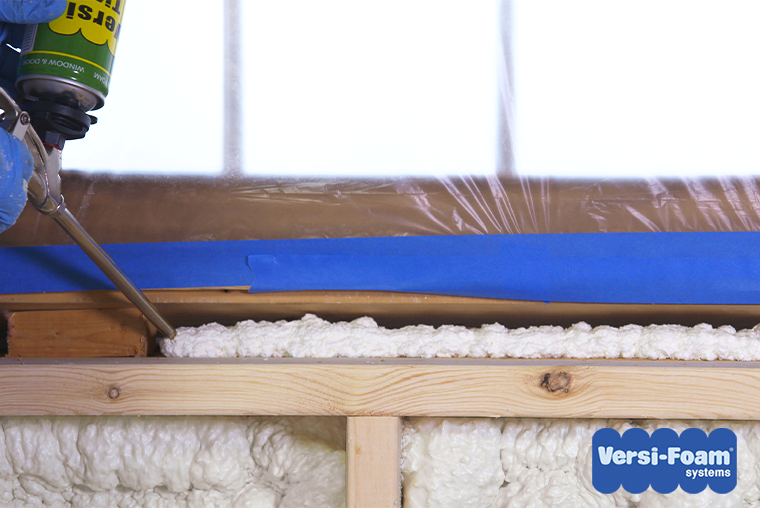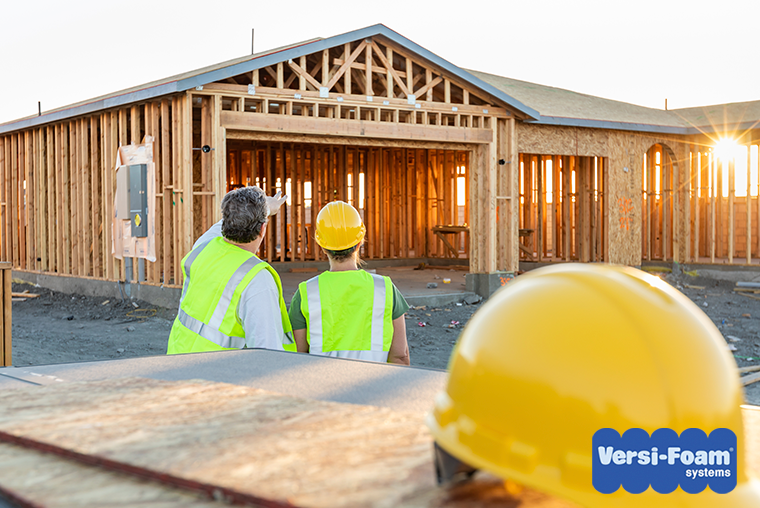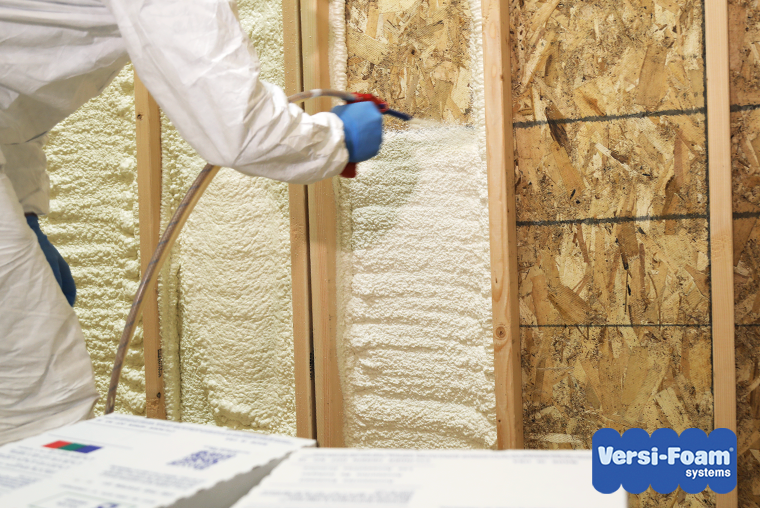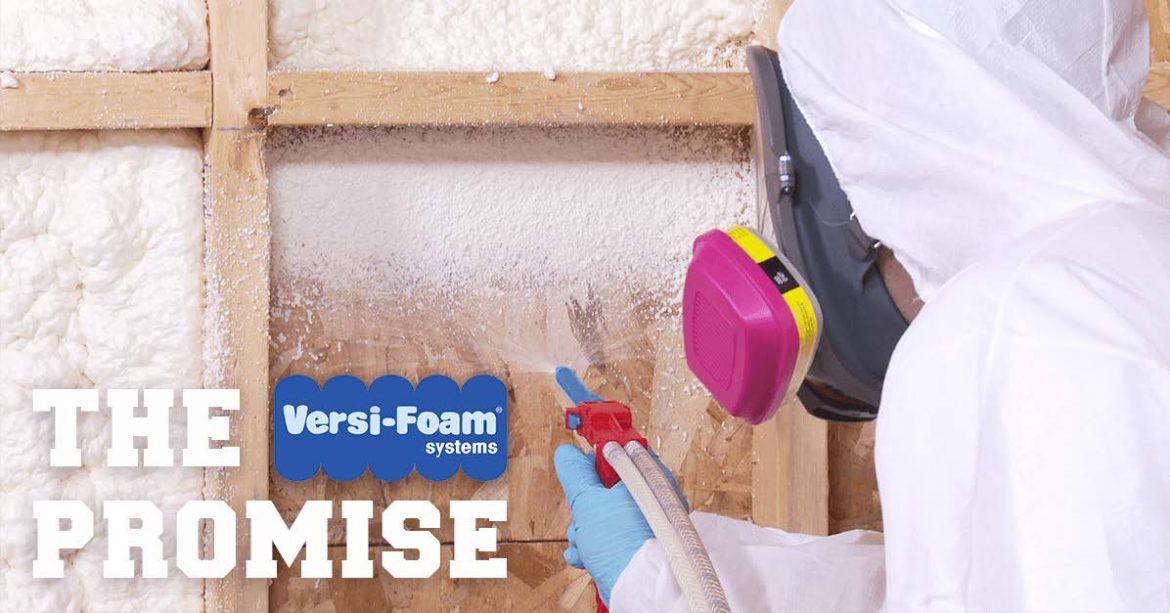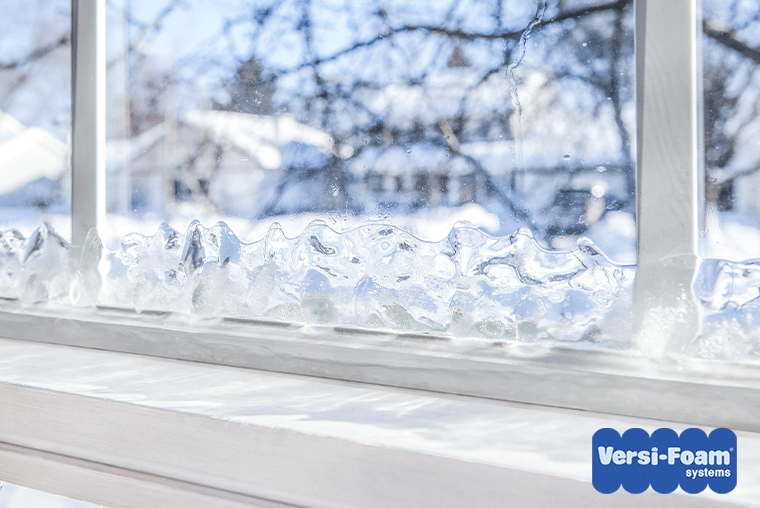VERSIFOAM® LATEST NEWS
A New Look VersiFoam® Ready for the Future of Spray Foam
For over 40 years, VersiFoam® has solidified its position as an industry leader in commercial and residential spray foam kit systems. Much like the rest of the world, the spray foam industry is undergoing big changes—most notably in regard to environmental regulations. An opportunity to lead by example, VersiFoam® has risen to the occasion by creating new Low GWP product formulations, improving the U-Control gun used for foam dispensing, and updating brand materials to support these new business initiatives.
Our New Look
VersiFoam® is one of the most popular spray foam insulations among professional contractors and installers. With this in mind, the updated brand materials had to pay homage to VersiFoam®’s heritage while modernizing the logo and packaging to complement the new and updated products.
In the new logo, the essence of the original remains, with its rounded lines and cloud-like shape reminiscent of the spray foam itself. The retro yet modern packaging proudly displays that our spray foam is made in the United States. There’s also no longer a hyphen in the VersiFoam® name, bringing every part of the company closer together.
Throughout the logo and packaging, the same color palette has been preserved—varying shades of red, white, and blue—but the new hues represent a more elevated version. The red stands out against the gentle blue backdrop, much like how our patented U-Control gun sets itself apart from every other spray foam dispensing gun on the market.
Our New and Improved Products
In early 2021, new regulations were put into effect to phase out hydrofluorocarbons (HFCs) previously found in spray foam. As such, VersiFoam® developed a new product line free of HFCs in accordance with the state phasedown. The new formula uses a Low GWP formula blowing agent—the future of the spray foam industry.
VersiFoam® also made improvements to the aforementioned U-Control gun, which comes with every one of our spray foam systems. The black nozzle has been lengthened for increased spray accuracy, and the internal elements have been updated to allow for better spray foam distribution and consumption.
Our Green Initiatives for 2024
Offering our customers an eco-friendly spray foam insulation option that meets all necessary state regulations is important to us. VersiFoam®’s new Low GWP formula offers a significantly lower global warming potential (GWP) and contains 0 lb/gal of VOCs, all while retaining an R-value of 6 per inch. Moreover, it improves air quality by eliminating all toxins, bacteria, and mold, as well as increases energy efficiency with its unique SPF insulation technology.
Need to stock up on spray foam? Find a VersiFoam® distributor near you.
It’s construction season, and we know that construction materials can be hard to come by right now—but not at Versi-Foam®. If you’re a distributor looking for spray foam insulation, you’re in luck, because we’ve got product available. Learn more about what Versi-Foam® has to offer and how our spray foam can help your clients complete all of the projects they have lined up this year.
Regulation-standard products
No matter what local regulations dictate, Versi-Foam® has products to suit your customer base. Our products do not contain any CFCs, Penta-BDEs, VOCs, or Urea-Formaldehyde. Moreover, we offer an eco-friendly formula that is Leed certified with 0 lb/gal of VOCs and no CFS’.
No hurdles, no delays
Your customers need spray foam, and they need it now. (Yesterday, even.) As a spray foam insulation distributor, it’s your job to make sure your shelves don’t go bare when they need more product. At Versi-Foam®, we have the following spray foam kits in stock for you:
- System 15: Available in Standard and Class I (flame-retardant) formulas, this closed-cell spray foam insulation kit produces 198 square feet of cured foam at a 1-inch thickness (16.5 cubic feet).
- System 50: Also available in Standard and Class I formulas, System 50 will produce 600 square feet of cured foam at a 1-inch thickness (50 cubic feet).
- System 10: This high-density system will produce 120 square feet of cured foam at a one-inch thickness (10 cubic feet).
- System 33: Another high-density spray foam, this system will produce 396 square feet of cured foam at a 1-inch thickness (33 cubic feet).
And we’ve saved the best news for last—there is only a one-week lead time on all of the spray foam insulation kits listed above. Versi-Foam® is here to help you get your customers the product they need in record time.
Flexible shipping
Let’s figure out a way to get you the product you need as quickly as possible. Versi-Foam® offers flexible shipping opportunities for distributors. We work with hundreds of distributors around the world, so we’re accustomed to working together to find a way to make sure everyone is happy. As such, our network spans far and wide, allowing us to help drive contractors and customers to you both online and in-store.
Solid R-values
We know what you’re really curious about, and that’s the R-values of our products. Of the closed cell spray foam systems we currently have in stock, all of the Standard formula kits have an R-value of R-7.7 per inch, while the Class I formula has an R-value of R-6.7.
P.S. Did you know Systems 10 and 33 are both great options for roof repairs? Trust us—you’ll want to make sure you have some in stock.
Are you a distributor? Order spray foam now! Limited quantities are available.
As a manufacturer of spray polyurethane foam (SPF), Versi-Foam® must adhere to the regulations put in place by the Occupational Safety and Health Administration (OSHA). We make sure all of our customers are aware of what using spray foam insulation entails and how to do so safely, and we promise to always keep you up-to-date on the latest rules and regulations, such as the newly implemented state phase-down of hydrofluorocarbons.
1. Hazard Communication
Before you use any kind of spray foam insulation product, it’s important to understand the potential risks of using this type of material. On the Versi-Foam® website, you can find an SDS on each product, which is available in both English and Spanish. You’ll find a list of warnings to avoid inhalation and any contact with your skin or eyes.
2. Respiratory Protection
When you are spraying foam insulation, you must have respiratory protection to prevent exposure to any potential hazards. There are different types of respiratory protection, often simply referred to as respirators, available depending on the type of product being used or airborne concern at hand.
3. Personal Protective Equipment (PPE)
Respiratory protection is only one type of personal protective equipment (PPE). Most often, PPE is used to prevent injuries or illnesses that can occur in the workplace. If PPE is required, such as when working with spray insulation, you must always be provided with the following information:
- When it’s necessary
- What kind is necessary
- How to properly put it on, adjust, wear, and take it off
- Limitations of the equipment
- Proper care, maintenance, useful life, and disposal of the equipment
You can find all of this information in the aforementioned SDS for each product.
4. Free Consultation Program
While less applicable for residential use, OSHA will provide a free consultation for both small and large businesses across the U.S. so employees can easily find out whether there are any workplace hazards they should be aware of. These on-site consultations also allow businesses, like worksites for commercial projects, to learn and improve without the risk of receiving a citation.
As stated on the OSHA website, “consultants from state agencies or universities work with employers to identify workplace hazards, provide advice for compliance with OSHA standards, and assist in establishing and improving safety and health programs,” performing “over 26,000 visits to small business worksites covering approximately 1 million workers across the nation.”
5. State Phase-Down of Climate-Damaging Hydrofluorocarbons
In May 2021, the U.S. Environmental Protection Agency (EPA) announced that it would be “proposing its first rule [to] phase down the production and consumption of hydrofluorocarbons (HFCs), highly potent greenhouse gases commonly used in refrigerators, air conditioners, and many other applications.”
The final rule of the new regulation under the American Innovation and Manufacturing (AIM) Act sets baseline levels for HFC production and consumption, from which reductions will occur. This “establishes an initial methodology for allocating and trading HFC allowances for 2022 and 2023, and creates a robust, agile, and innovative compliance and enforcement system,” as stated by the EPA.
Before the official ruling took hold, some states already ruled to stop the manufacturing and use of products containing HFCs, including spray foam insulation. These states include California, Colorado, Hawaii, Maine, Massachusetts, New Jersey, New York, Vermont, and Washington. As such, Versi-Foam® created a new formula that uses hydrofluoroolefins (HFOs), a blowing agent that has a lower global warming potential (GWP).
While the cost to manufacture this material is higher, its price should come down over time as more states put into place this new regulation and more companies begin to produce HFOs. Be sure to check your local regulations to make sure you order the right product for your area. No matter where you live, Versi-Foam®’s environmentally-friendly products are energy-efficient, LEED-certified, and readily available to you.
While many are familiar with wall insulation, less may know about the importance of window and door insulation. To ensure a building or home is as energy efficient as possible, it’s crucial to properly install insulation around every door and window. With the right product, window and door insulation can be a breeze. Discover why Versi-Tite® is the perfect solution for your windows and doors.
Understanding window and door insulation
Important for more than just homes, window and door insulation is crucial for both new builds and repairs and renovations to older structures. This can be done through caulking and weatherstripping. Preventing drafts or getting rid of old ones helps increase a building’s energy efficiency, lowers heating and cooling bills, and more.
As the U.S. Department of Energy article, “Air Sealing Your Home,” states, “During cold or windy weather, too much air may enter the house. When it’s warmer and less windy, not enough air may enter, which can result in poor indoor air quality. Air leakage also contributes to moisture problems that can affect occupants’ health and the structure’s durability. An added benefit is that sealing cracks and openings reduces drafts and cold spots, improving comfort.”
What is Versi-Tite®?
Versi-Tite® is our solution to seal and protect the windows and doors on all of your projects, as well pipes, outlets, and any other penetrations or openings. This one-component polyurethane foam is a moisture-cured product used to seal small gaps and crevices up to an inch wide and provides a full cavity fill without warping or bowing the frames. (For anything bigger than an inch, Versi-Foam® is the product to use.)
Some of the most common uses of Versi-Tite® include to:
- Seal window and door sills, frames, jambs, and headers
- Close leaky gaps in roofs and attics
- Seal air conditioning penetrations
- Stop air infiltration through windows and electrical outlets
- Seal radon gas entry routes
- Provide positive air sealing in asbestos removal areas
- Seal utility penetrations
- Prevent dust and moisture entry through plate lines
Depending on the size of your project, Versi-Tite® comes in an easy-to-use, 24-ounce can with a 3/8-inch caulking bead, a 10-pound tank, and a 16-pound tank. The can covers 1,842 linear feet. When used with our dispensing gun, it allows for a highly controlled application. Meanwhile, the tanks cover 8,688 and 13,914 linear feet, respectively, and both come with a 9.5-foot hose and dispensing wand—great for larger applications.
Explore our full Versi-Foam® and Versi-Tite® product range online. Find a dealer near you today!
We’ve covered hiring a green contractor—but what if you’re doing it yourself? No matter the size of your project, you must consider the environmental impact of your new build or renovation. How can you reduce your carbon footprint and increase your green building footprint?
Before you start gathering materials, the answer is clear: green products are the way of the future. Versi-Foam® has got environmentally friendly insulation covered for you, but here are the best green products for all of your other project needs.
Best green building materials
There are eco-friendly options to consider for every element of your upcoming project—from the materials used to craft the structure itself to the products you cover it with and put inside of it. In order to select the best green products for your next project, the following are some materials to consider.
Sustainable flooring
Using reclaimed wood is a fantastic way to save trees from being cut down and keep lumber out of landfills. According to Dumpsters.com, reclaimed wood is most often found from or through:
- Retired barns
- Salvage yards
- Shipping crates and pallets
- Excavation companies
- Home remodeling companies and contractors
- Specialty buyers
Other good options for sustainable flooring include bamboo, cork, mycelium, and ferrock. Bamboo works well as a replacement for traditional hardwood, though, cork is a desirable option, too, as it’s “highly renewable, but cork also has hypoallergenic properties, fire retardant qualities, and is resistant to liquids.”
Recycled steel
Particularly in areas where natural disasters or inclement weather, such as high winds and earthquakes, are prevalent, steel is the smarter material to use for a home or building’s beams. Steel construction materials are 100% recyclable, giving steel beams an infinite shelf life that drastically reduces your carbon footprint when you purchase them pre-owned.
Moreover, “steel is the material of choice by engineers and architects because of its inherent strong performance characteristics such as durability, reliability, versatility in design and consistency,” according to the American Iron and Steel Institute (AISI).
Energy-conserving windows and doors
The windows and doors you choose can greatly affect the overall sustainability of your home and its effect on the environment—and your wallet. Energy efficient windows are the smart choice, specifically windows made with Low-E, or low-emissivity, glass.
Low-E windows have a special coating that allows them to reflect both short- and long-wave infrared rays. This prevents heat transfer and ensures that only visible light is able to pass through the glass from either direction. You get all of the light and none of the increase in temperature, as well as lower energy bills and less fading of furniture, rugs, and carpet.
Energy-efficient insulation
Versi-Foam® spray foam insulation kits offer an energy efficient and LEED-certified option that will also save you time and money. This easy-to-use product boasts SPF insulation technology that helps you reduce your use of fossil fuels, which means less greenhouse gases emitted. Much like cork’s hypoallergenic properties, Versi-Foam® insulation also enhances interior air quality—eliminating nearly all bacteria, toxins, mold, and asthma-threatening elements.
Solar panels or roof tiles
Solar panels are a well-known piece of sustainable technology and a great source of renewable, or clean, energy, but have you heard of solar roof tiles? Designed to look like standard asphalt shingles, solar roof tiles can be installed as part of the roof itself or mounted on brackets on top of pre-existing shingles.
While both have their advantages, installing solar technology of any kind will save you money, improve the value of your home and your environmental impact, require little to no maintenance, and provide energy independence. You will also be eligible for the Solar Investment Tax Credit (ITC) in the U.S.—a 26% tax credit applicable for both residential and commercial structures.
Let us help you choose the right insulation for your next project. Contact us today!
While “green building” is by no means a new concept, it is one that has continuously increased in popularity. Green building refers to “the planning, design, construction, and operations of buildings with several central, foremost considerations: energy use, water use, indoor environmental quality, material section, and the building’s effects on its site,” according to the U.S. Green Building Council (USGBC).
Central to respecting the environmental impact of both new builds and renovations to pre-existing ones is finding a green general contractor to oversee and manage your project. So, how do you find the right contractor? Discover what makes a contractor green and how to pick the right professional to go green for your next project.
What are green contractors and how to find one
Green contractors specialize in sustainability, both in terms of design and construction. There are some formal certifications that contractors can obtain, including the:
- Green Associate or Accredited Professional by the Leadership in Energy and Environmental Design (LEED)
- Certified Green Contractor by the Associated Builders and Contractors (ABC)
These certifications, however, are not a mandatory requirement, so how do you determine if the contractor you’re talking to is a green contractor?
There may not be a resource in your area for you to easily find a professional in this area, so the following are some questions, written by Ecohome, on what to ask to ensure your contractor understands green principles, including energy efficiency and sustainability:
- Do you build high-performance/energy-efficient homes?
- Do you build airtight homes?
- Do you conduct blower door tests?
- Do you do energy modeling?
- What do you do to avoid thermal bridging in walls?
- What are your preferred types of insulation?
- Which type of wall assembly do you recommend?
- What is the most important feature in a home that affects energy efficiency?
- Why do many basements smell moldy?
Their answers to the above questions will give you a strong indication of whether or not the contractor you’re speaking to has experience in green building. Moreover, contractors with experience in green building typically take pride in showing off past projects and will have references for you to contact.
What makes Versi-Foam® an environmentally friendly choice
An important element of a contractor’s process is choosing the right materials to complete the project at hand. Versi-Foam® provides a unique solution for green contractors, as all of the different spray foam insulation kits we offer are energy efficient and LEED-certified.
Due to unique SPF insulation technology, you’re able to save energy and reduce the use of fossil fuels, which, in turn, helps reduce greenhouse gases. Versi-Foam® spray insulation also improves air quality by preventing nearly all bacteria, toxins, mold, and asthma-threatening elements from getting into your building or home.
With our product, there is a significant reduction in wasted materials, too, thanks to our easy-to-use applicator and long-lasting strength. Versi-Foam®’s applicator, the patented U-Control dispensing gun, allows you to get into every nook and cranny and prevent moisture and mold from eating away at your house or commercial building.
Did you know you can get a tax credit for using Versi-Foam? Learn how to qualify and let us help you get set up for your next project. Contact us today!
With home renovation at an all-time high, there’s no better product to recommend to your clients than Versi-Foam’s residential insulation spray foam kit. These spray foam kits are both low pressure and easy to use—making them a highly marketable choice for distributors. (And let’s not forget about our industry-leading commercial spray for larger projects, too!) Keep reading to learn what The Versi-Foam Promise really means.
What does The Versi-Foam Promise include?
They save, you save
When you choose Versi-Foam for your insulation needs, you’re getting The Versi-Foam Promise along with it, but what does this include? Your customers will love how much they’ll save—both in time and money—with our high-quality, easy-to-use product. As a distributor, there are savings in it for you, too, when it comes down to ordering and shipping our product to you. We’ll work together to get you the best total price guaranteed.
Expert-level background knowledge
Moreover, we know spray foam, and we know it well. Versi-Foam Founder Richard Heitzer understood spray foam like the back of his hand, thanks to his background in the cold storage construction industry. He patented a one-of-a-kind gun for distributing spray foam. The U-Control gun lets you regulate the “quantity of foam being dispensed […] down to a rate that you can write your name with it.”
Support you can count on
Got questions? We’ll never keep you waiting. With a small, yet mighty, team of highly trained employees, the relatively small size of our company allows us to provide uniquely personalized customer service and a quick turnaround time. Whether you’re looking for more product information, need help determining how much product to order, or anywhere between, you can count on Versi-Foam to find the perfect solution. Our goal is to provide you with a high-quality versatile product that fits all your needs—and customer service to match.
Ready to become a Versi-Foam distributor? Give us a call at 1 (800) 657-0702 today!
Once you’re ready to start your next insulation project—and before you pick up your Versi-Foam U-Control gun—it’s important to understand each type of insulation and what’s included in your Versi-Foam kit for each one. Inside each kit, you’ll have everything you need to successfully complete the spray foam insulation process. Find out more about all of the different spray foam options we have to offer, and let us help you determine which Versi-Foam kit is right for you.
Types of spray foam insulation
The type of Versi-Foam insulation you choose will determine what you’ll find in your Versi-Foam kit. We offer four main types of spray foam to fit all of your project needs: closed cell, open cell, high density, and slow rise.
Closed cell
Closed cell spray foam insulation is recommended for most commercial and industrial projects and comes in two different formulations: Standard formula and Class I formula, the latter of which is flame-retardant. The Class I formula is best suited for residential applications or other applications where flammability is of concern.
There are six different closed cell options, and each kit is slightly different:
-
System 1
-
-
- Comes with:
- Two aerosol cans in a plastic carriage inside of a fiberboard box
- Thumb-roll mechanized dispenser
- Will produce 12 square feet of cured foam, or one cubic foot, at a 1-inch thickness
- Designed to be used on the same day it’s opened
- Available in both Standard and Class I formulas
- Comes with:
-
-
System 9
-
-
- Comes in one carton with:
- Two chemical components
- U-Control dispensing gun attached to two 10-foot hoses
- Ten (10) mixing nozzles
- Three (3) fan tips
- Will produce 108 square feet of cured foam, or 9 cubic feet, at a 1-inch thickness
- Available in both Standard and Class I formulas
- Can be shut down and used on another day
- Once open, must use entirely within 30 days upon and must be used at least once every seven days
- Comes in one carton with:
-
-
System 15
-
-
- Comes with all of the same items as System 9
- Will produce 198 square feet of cured foam, or 16.5 cubic feet, at a 1-inch thickness
- Available in both Standard and Class I formulas
- Can be shut down and used another day
- Once open, must use entirely within 30 days upon and must be used at least once every seven days
-
-
System 50
-
-
- Comes in two cartons with:
- Two chemical components
- U-Control dispensing gun attached to two 15-foot hoses
- Ten (10) mixing nozzles
- Three (3) fan tips
- Will produce 600 square feet of cured foam, or 50 cubic feet, at a 1-inch thickness
- Available in both Standard and Class I formulas
- Can be shut down and used another day
- Once open, must use entirely within 30 days upon and must be used at least once every seven days
- Comes in two cartons with:
-
-
Hy-Flo System 700
-
-
- Comes in four cartons with:
- Two sets of chemical tanks partially filled and more heavily pressurized
- U-Control dispensing gun attached to two 20-foot hoses
- Twelve (12) flash spray nozzles
- Three (3) multi-purpose mixing nozzles
- Will produce 700 square feet of cured foam at a 1-inch thickness
- Available as a Class I formula only
- Constant pressure system that will spray an even 14.5-inch wide pattern at 1-inch thick
- Can be shut down and used another day
- Once open, must use entirely within 30 days upon and must be used at least once every seven days
- Comes in four cartons with:
-
-
Hy-Flo System 350
-
- To be used as a spare set of chemicals for the Hy-Flo 700
- Consists of:
- A single set of chemicals with no accessories
- Will produce 350 square feet of cured foam at a 1-inch thickness
- Can be shut down and used another day
- Once open, must use entirely within 30 days upon and must be used at least once every seven days
Open cell
Open cell spray foam insulation is appealing to many for its high expansion rate, which means less foam is necessary when applying, making it more cost-effective. These kits, however, are dependent on temperature—their yield will be significantly less in cooler weather. This is because open cell foam relies on an exothermic chemical reaction, i.e., building off of its own heat, to reach its full potential.
-
System 31
-
-
- Comes in one carton with:
- Two chemical components
- U-Control dispensing gun attached to two 10-foot hoses
- Ten (10) extended mixing nozzles
- Three (3) fan tips
- Will produce 380 board feet of cured foam, or 31 cubic feet, at a 1-inch thickness
- Available as a Class I formula only
- Can be shut down and used another day
- Once open, must use entirely within 30 days upon and must be used at least once every seven days
- Comes in one carton with:
-
-
System 100
-
- Comes in two cartons with:
- Two chemical components
- U-Control dispensing gun attached to two 15-foot hoses
- Ten (10) extended mixing nozzles
- Three (3) fan tips
- Will produce 1,200 board feet of cured foam, or 100 cubic feet, at a 1-inch thickness
- Available as a Class I formula only
- Can be shut down and used another day
- Once open, must use entirely within 30 days upon and must be used at least once every seven days
- Comes in two cartons with:
High density
For those who need a higher density spray foam option, Versi-Foam has you covered with this closed cell product with a free-rise density of 2.8 pounds per cubic foot, or 3 pounds per cubic foot in place. Its low moisture absorption rate and excellent compressive strength make it the ideal option for projects where a stronger and harder material is needed. Moreover, it has an expansion rate six times its original liquid volume and is tack-free in approximately 30 to 45 seconds.
-
System 10
-
- Comes in one carton with:
- Two chemical components
- U-Control dispensing gun attached to two 10-foot hoses
- Ten (10) mixing nozzles
- Three (3) fan tips
- Will produce 120 square feet of cured foam, or 10 cubic feet, at a 1-inch thickness
- Can be shut down and used another day
- Once open, must use entirely within 30 days upon and must be used at least once every seven days
- Comes in one carton with:
-
System 33
- Comes in two cartons with:
- Two chemical components
- U-Control dispensing gun attached to two 15-foot hoses
- Ten (10) mixing nozzles
- Three (3) fan tips
- Will produce 396 square feet of cured foam, or 33 cubic feet, at a 1-inch thickness
- Can be shut down and used another day
- Once open, must use entirely within 30 days upon and must be used at least once every seven days
- Comes in two cartons with:
Slow rise
If slower reactivity is what you need, we also offer spray foam insulation with a density of two (2) pounds per cubic foot that takes approximately three (3) minutes to dry. Our Slow Rise formula is just the thing for projects where you need the insulation to flow to a specific area before drying.
It’s important to note that this option does expand to approximately six times its original liquid volume. As such, it’s not recommended for use in wall cavities where one or more sides of the wall are gypsum wallboard or other material that would not withstand the pressure of the expansion.
-
System 9 Slow Rise
-
-
- Comes in one carton with:
- Two chemical components
- U-Control dispensing gun attached to two 10-foot hoses
- Ten (10) mixing nozzles
- Three (3) fan tips
- Will produce 108 square feet of cured foam, or 9 cubic feet, at a 1-inch thickness
- Available as a Class I formula only
- Can be shut down and used another day
- Once open, must use entirely within 30 days upon and must be used at least once every seven days
- Comes in one carton with:
-
-
System 15 Slow Rise
-
-
- Comes with all of the same items as System 9 Slow Rise
- Will produce 200 square feet of cured foam, or 16.5 cubic feet, at a 1-inch thickness
- Available as a Class I formula only
- Can be shut down and used another day
- Once open, must use entirely within 30 days upon and must be used at least once every seven days
-
-
System 50 Slow Rise
-
- Comes in two cartons with:
- Two chemical components
- U-Control dispensing gun attached to two 15-foot hoses
- Ten (10) mixing nozzles
- Three (3) fan tips
- Will produce 600 square feet of cured foam, or 50 cubic feet, at a 1-inch thickness
- Available as a Class I formula only
- Can be shut down and used another day
- Once open, must use entirely within 30 days upon and must be used at least once every seven days
- Comes in two cartons with:
Our goal is that this guide helps to give you an idea of what to expect from each kit and how to choose which one is best for your needs. No matter what kit you buy, you’ll always have our Versi-Foam Promise—high-quality, easy-to-use products coupled with expert customer support, guaranteed.
Need some assistance to figure out what type of insulation is right for you? Our team is here to help! Email us at sales@versifoam.com, or give us a call at 1 (800) 657-0702 today.
Spray foam insulation is one of the most popular insulating materials available. Consequently, there has been a lot written about its pros and cons, including plenty of stories of spray foam insulation gone wrong. It’s important to remember that not everyone who chooses and uses spray foam insulation takes the time to learn how to use it properly, leading to mistakes and rework.
From lack of preparation to ignoring thickness limitations, we’ve seen it all. When used according to the manufacturer’s instructions, spray foam insulation can be installed without problems and without drama. Here is our quick-start guide to preventing common spray foam installation problems and what to do if something doesn’t go as planned.
First, pick the best insulation for your project. If you’re unsure which formula you need, read this blog post on the Differences Between Spray Foam Insulation Products. Next, read the rest of this article to learn what to keep top of mind as you complete your project.
Spray foam insulation mistakes generally fall into five categories.
- The work area wasn’t prepared properly before application.
- Foam was applied to a surface that wasn’t completely dry.
- The foam wasn’t applied at the required thickness.
- The foam containers weren’t brought to the proper temperature before spraying or the ambient temperature was too hot or cold.
- Container A and container B aren’t mixing properly as the foam is dispensed.
Let’s take a closer look at each of these.
Preparation
Management of overspray is an important part of pre-application preparation. Overspray happens when the product becomes airborne after the chemicals have been mixed. It lands on surfaces in the surrounding area, expands, and dries. It’s important to seal off the area with plastic sheeting and cover anything that can’t be moved. It’s also important to extinguish ignition sources in the area and make sure that people don’t smoke where the spray is being applied.
Surface Area
If you spray foam on a surface with a moisture level of more than 20%, the foam won’t stick. The surface has to be paintable for the foam to adhere. “When a surface is wet or damp, the moisture acts as a blowing agent that reacts with the “A” side of the SPF system, resulting in off-ratio foam with poor physical properties and poor adhesion.” (source) So make sure to test the moisture level before you spray.
Thickness
If the foam is sprayed thicker than recommended for its type, excessive heat can result causing odors, cracks, shrinkage, or charring. To prevent this, never spray more than a 2” thickness at a time. To spray more than 2”, apply in layers allowing the foam to cure for at least 15 minutes between layers.
Temperature
The ideal temperature for both the foam and the surface is between 65° F and 90° F. Surfaces that are colder will result in reduced yield because the cold surface extracts heat from the exothermic reaction resulting in a reduced rise. If the surface is 40° or colder, the exotherm may also cause condensation, which would be like spraying foam onto a wet surface (see above).
Surfaces that are too warm may result in the foam curing too fast. This would also result in a reduced yield because the foam would not have enough time to reach the full rise before a tack free state. In addition, extreme cases may result in loss of adhesion because the foam would cure so fast it could not develop a bond to the surface before it hardened. If you’re unsure if the temperature is right, do a test patch first.
Mixing
Good quality foam is dependent on one-to-one ratio dispensing. Incorrectly mixed chemicals result in foam pulling away from the surface and lingering odors. The easiest way to determine that you have a good ratio is to observe the stream of chemicals coming out of the gun before they pass through the mixing nozzle. If the two chemical streams aren’t flowing at equal velocity, check the dispensing gun for proper function and the temperature strips to make sure the chemicals are in the mid-green section.
Sometimes you’ll know immediately if something has gone wrong. But other times mistakes in application may not show up for a while. If you see any of the following signs, it means you need to take a closer look at your insulation.
- Moisture in the attic
- HVAC working overtime
- Ice dams on the gutters
- Rooms inconsistently heated or cooled
- A pest infestation
- The spray foam contracts and pulls away from framing.
If you want to know more about preparing for and executing a successful spray foam installation, check out our FAQ page check or our Video Library. Or give us a call and we’ll be happy to discuss the details of your project with you. 1.800.657.0702

